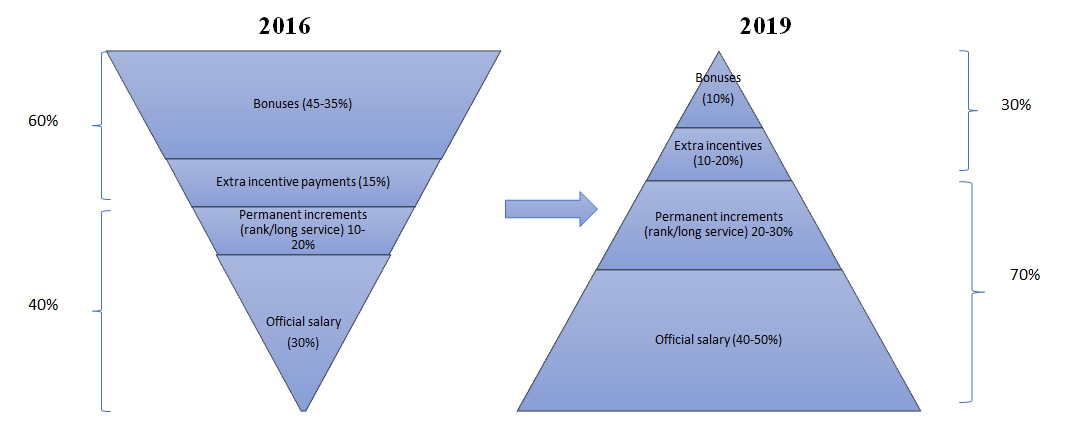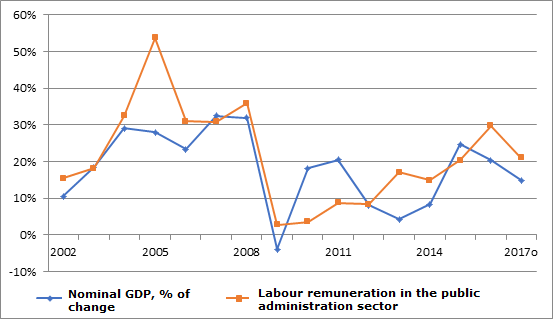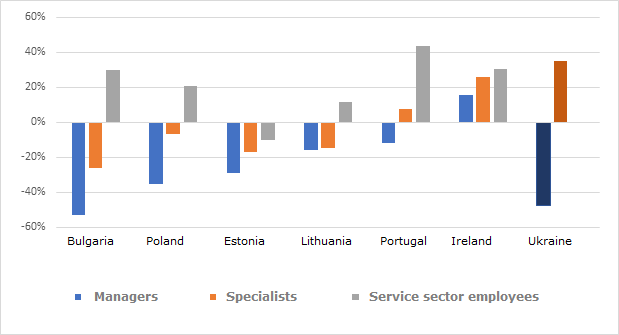Over the past few years, the general public and the donors have been calling on the Ukrainian government for reforms implementation, yet the process is painstakingly slow: for the period from June 19 to July 2, 2017, Reform Index totaled +0.4 points out of the maximum 5 possible. When it comes to reforms, most people talk about the political will to change the country, the key question being “Why do reforms?” However, even with the political will present, it is not enough to simply pass a law or a resolution – implementation at all levels remains a key success factor. At this point, the question becomes “Who executes reforms?” These are ordinary civil servants, middle- and low-level administrative personnel, whose quality of work determines the quality of implementation of the best laws or policies adopted by the top-level government officials.
Ukraine’s public administration sector has been undergoing reform process for the last two years. The most important milestones have been the adoption of the new Law On Civil Service at the end of 2015, and the Strategy for Reforming the Public Administration of Ukraine in 2016-2020. In general, the law meets the European principles of public administration and aims to address the main problem areas of civil service. However, as of 2017, the system is still far from being perfect: the effective mechanism of civil servants labor remuneration does not allow to recruit new professional staff, despite costing taxpayers a hefty amount. The cost of labor remuneration in the public sector is expected to reach 10.8% of the Ukrainian GDP in 2017 – too high for a transition economy with a large debt burden; only economically developed countries can afford such costs. For example, the share of government spending on labor remuneration in the EU in 2016 on average totaled 10.2% of the GDP, while among the EU neighbors of Ukraine – 9.6% of the GDP.
The new law introduced two important elements. The first is open competitions for civil service offices that in theory should have opened the doors for candidates “from outside the system.” 26,000 recruitment competitions have been held since inception, while civil service has become one of the top three spheres in the labor market by the number of open vacancies. The second achievement is an increase in salaries and changes in the structure of labor remuneration. However, both achievements have later demonstrated their drawbacks.
In this article, we will focus on the drawbacks of the labor remuneration system that effectively demotivate new candidates to participate in competitions, negatively affecting overall outcomes of the reform and effectiveness of the new law. Sooner rather than later, Ukraine will face the need to correct the distortion caused by the disproportions in the remuneration system.
What Drawbacks Have Remained in the New Labour Remuneration System?
For public sector employees, Ukraine has a centralized system of labor remuneration based on the tariff scale. The salary consists of base, provisional, and reward-based (bonus) components.
The base components are the official salary plus guaranteed increases for length of service and civil service rank. In addition, civil servants are entitled to two types of financial aid that are, in fact, also guaranteed bonuses: assistance for social/family needs and assistance for health/medical needs, received together with annual vacation pay.
Bonuses and provisional payments are additional incentives that depend on the conditions and complexity of work, as well as performance results.
Table 1. Components of labour remuneration in the public administration sector in Ukraine
| Contractual components, including: | Motivational components | |||
| Monetary | Non-monetary | |||
| Current labour remuneration | Basic component | Official salary | Permanent employment
(career system actually provides for a life-time employment), social security: labor relations are fully consistent with the Labor Code; departmental healthcare and recreation facilities; an opportunity to get corporate housing; a longer paid leave (30 days compared to 24 days according to the general labor legislation) |
|
| Increments:
permanent: for long service, for the civil service rank
Financial aid to settle social and household issues Financial aid for recreation |
||||
| Temporary component | Performance-based bonuses (optionally): monthly/quarterly/annual
Increments: temporary: for extra workload (fulfillment of duties of a temporary absent official/fulfillment of duties in a vacant office), for a particularly important work; for labour intensity |
|||
| Preferential component | Healthcare (on a centralized level); corporate housing | In-service education, training. | ||
| Anticipated remuneration | Pension* | Privatization of corporate housing | ||
Source: ESC based on the effective legislation of Ukraine.
The first problem stems from the fact that a large share of variable components in the salary structure make civil servants exceedingly loyal to their management and vulnerable to corruption pressures. Salary bonuses, determined by immediate supervisors and approved by the top management, form a significant part of total remuneration and are set in a non-transparent manner using a complicated mechanism.
While the new law increased the share of base salary from 26% in 2015 to 34% in 2016, it still remains too low. The provisions of the new Law on Civil Service aim to gradually correct these distortions (see Figure 2).
Figure 2. Actual and anticipated structure of labour remuneration (according to the Law), % of the total payment

Source: ESC calculations based on the effective regulatory acts.
From January 1, 2018, the minimum base salary of civil servants will increase up to 1.5 times the subsistence minimum, and from July 1, 2018 – up to 1.75 times.
From January 1, 2019, quarterly bonuses shall be limited to 30% of the annual base salary of civil servants, whereas the overall bonus pool shall total no more than 20% of the annual salary fund for the year.
These are drastic changes compared to the effective regulations, because today the savings of the salary fund are distributed as bonuses, which often becomes a subject of manipulations. Managers can deliberately keep a certain number of vacancies open in order to increase the amount of available resources (the so-called “salary fund savings”) to provide incentive payments to their subordinates. For example, Kostiantyn Vashchenko, head of the National Agency of Ukraine on Civil Service, believes the share of such vacancies may reach up to 10-15% of the payroll. On one hand, it allows managers to legally pay almost market-level salaries to their subordinates, but on the other hand, the system can become a subject of managers’ manipulations.
The second problem is discrimination in the remuneration of young professionals and specialists outside the civil service system, as bonuses for the length of service can reach up to 50% of an employee’s income. Unfortunately, the new law preserves this drawback. Thus, a top manager coming from a non-governmental sector can get almost the same total salary as a mid-level employee with a long record of service. These situations are quite common: according to the Statistics Service of Ukraine, in 2015 the share of managers of all levels and categories employed in civil service for 15+ years (i.e. those who receive bonus for the length of service of 45-50% of the salary) totaled 46%, while another 26% of managers have been employed in civil service for 10-15 years (and get a 30-42% increase accordingly).
To get an idea of the total amount of remuneration of civil servants employed at the central apparatus, we have calculated average monthly salaries taking into account the minimum and the maximum increases provisioned by law (see Table 2).
Table 2. Nominal calculation of a monthly salary of a civil servant employed at a central executive agency based on official monthly salaries before tax set for 2017
| Office | Official salary, UAH (1) | Guaranteed increments and payments, % of the official salary (2) | Bonus, % of the official salary (3) | Temporary increments and payments** , % of the official salary (4) | Average monthly salary, UAH | ||||
| Long service | Rank | Financial aid and other payments* | |||||||
| min | max | minimum (1+2) | maximum (1+2+3+4) | ||||||
| State secretary | 13,000 | 3% | 50% | 8% | 109% | 30% | 170% | 28,589 | 60,699 |
| Head of a state agency | 13,000 | 3% | 50% | 8% | 18% | 30% | 170% | 16,788 | 48,898 |
| Head of a department / service | 9,115 | 3% | 50% | 8% | 18% | 30% | 160% | 11,770 | 33,372 |
| Head of an independent department / service | 8,670 | 3% | 50% | 8% | 19% | 30% | 160% | 11,235 | 31,783 |
| Head of an independent department / service | 8,200 | 3% | 50% | 9% | 19% | 30% | 160% | 10,670 | 30,104 |
| Head of a department | 7,300 | 3% | 50% | 7% | 18% | 30% | 160% | 9,356 | 26,657 |
| Head of a unit | 6,900 | 3% | 50% | 7% | 18% | 30% | 160% | 8,875 | 25,228 |
| Head of a sector | 6,400 | 3% | 50% | 8% | 18% | 30% | 160% | 8,274 | 23,442 |
| Senior expert at a state agency | 5,900 | 3% | 50% | 7% | 18% | 30% | 160% | 7,557 | 21,540 |
| Leading expert at a state agency | 4,600 | 3% | 50% | 5% | 18% | 30% | 160% | 5,878 | 16,780 |
| Expert at a state agency | 4,200 | 3% | 50% | 4% | 18% | 30% | 160% | 5,280 | 15,234 |
*Two types of financial aid – to cover recreation during the annual paid leave and to settle social and household issues – taken together. A state secretary gets two guaranteed increments – for the intensity of labour and for fulfilling especially important tasks (in the amount of not less than 50% of the official salary in each case).
**It includes all possible additional payments and temporary increments provided for by the effective law: for extra workload; for the intensity of labour; for fulfilling especially important tasks, for the participation in preparation of legislative acts, for access to confidential information, etc.
Source: ESC calculations based on the effective regulatory acts.
The third problem is that employees of different central authorities receive different salaries. The officials of the newly established anticorruption agencies (the NABU and the NAPC) get the highest salaries – several times higher than those paid to the top-level civil servants (state secretaries). The official salary of a prosecutor at the General Prosecutor’s Office is comparable to the salary of a head of a central government agency. This approach contradicts the principle of equal pay for equal work.
This problem is also evident in the case of average indicators. Thus, in 2016, the average monthly salary in different ministries ranged from 2,282 UAH to 9,377 UAH, while the average rate for all ministries was 6,374 UAH per month.
Salaries vary considerably even within the same department or within different units of the same type (ministries, agencies, services). This demotivates employees, especially if they do not understand the reasons behind these disproportions.
Lesson for Ukraine
To tackle these and other problems, it is necessary to conduct a detailed analysis of differences in labor remuneration and the impact of various potential changes on the total labor remuneration expenditures in public sector. This requires a centralized database of personnel records and labor remuneration of civil servants. According to Kostiantyn Vashchenko, head of the National Agency of Ukraine on Civil Service, the realization of such system, financed by the donors, will be completed by the end of 2017.
Why a Large Share of Bonuses Does Not Motivate Civil Servants
The world practice shows that countries experimented with various salary components in every possible way, but it did not always result in highly motivated the employees or improved quality of work.
In 1980s, on the wave of the public administration reforms, the developed countries made remuneration partly dependent on the results of the employee’s performance (performance-based pay). Other countries have followed the suit.
In addition, many countries cut down on the share of variable and provisional components of labor remuneration and increased the guaranteed (base) share. According to the OECD study [1], in 2011, bonuses and other additional payments on average accounted for only 20-35% of the employees’ salary.
There are a number of ways to motivate the staff based on their performance, as well as numerous performance assessment methods.
For example, Portugal [2] has introduced the following rule for the bonus fund distribution: one quarter of employees throughout the system receive bonuses for the acceptable level of performance, of which 5% receive higher bonuses if their performance is recognized as exemplary. If the performance of the entire agency is deemed exemplary, the bonus fund is distributed among 35% of all employees, of which 10% (including managers) receive bonuses for exemplary performance.
Germany[3] introduced performance-related pay in 1997 in the form of either a one-off annual bonus equal to a base salary or a monthly bonus reaching up to 7% of the base salary.
Some countries have set a limit on the share of bonuses and increments in the total monetary compensation payable to civil servants. For instance, in Latvia and Slovenia [4], the cumulative amount of all bonus payments shall not exceed 40% and 55% of the total pay. After the reform in Lithuania, the average level of bonus payments has dropped to 20% of the total salary, while the maximum amount of all bonuses and increments does not exceed 70% of the total remuneration.
Have motivational schemes made employees’ work more effective? Not everywhere. According to the surveys, only 31% of the Lithuanian civil servants believe that high productivity leads to higher wages. In Estonia, 50% think so, in Latvia – 30%, in Poland – 18%. [5]
This is partly explained by imperfect systems of performance assessment, and partly by the fact that, as it turns out, the public sector employees are less motivated by money than people employed in the private sector.
The results of survey of civil servants in different countries show that when it comes to motivation, the following factors are most important: the feeling that one’s work is meaningful and affects the decision-making process, opportunities for career advancement, social security, pensions, and prestige of the civil service.
Lesson for Ukraine
A country with limited budget resources and high corruption risks should make the system of bounces as simple as possible, linking monetary incentives to the goal of the public service reform. For example, it is advisable to cut down the maximum bonuses for the length of service from 50% to 30% or to re-qualify it as a bonus for the relevant experience, including the experience received outside the civil service. It is also worthwhile to analyze how the newly recruited and experienced civil servants are motivated by non-monetary factors: career prospects, involvement in the government decision-making, the opportunities for international assignments and business trips, general working conditions, access to basic amenities (well-equipped kitchen, up-to-date bathroom facilities, comfortable desk chairs), a culture of mutual respect, user-friendly workflow, etc.
Civil Service Does Not Always Mean Low Salaries
Civil service remains an unattractive employment sector for the Ukrainians. According to the National Agency of Ukraine on Civil Service, in the follow up of the competitions to fill 26,000 civil service offices, only 2% of the vacancies were taken up by the people without any previous experience in the public sector. Ukrainians often believe that salaries in the public sector are low and, thus, are not interested in applying for these jobs. However, this is not always true.
Salary Growth Rates
Salaries of civil servants did not lag behind the economic growth rates – in 2001-2015, labor costs in the public administration and defense sectors exceeded the growth rate of nominal GDP by 35%.
The salaries have been changing in a non-regular manner. However, over the past 15 years, labor costs have been growing faster than the GDP. After the Law On Civil Service was adopted, the payroll fund of civil servants and the average salaries more than doubled in 2016, while in 2017 another increase of 48% is anticipated.
Figure 3. Change in nominal GDP and labor costs in the public administration sector in 2001-2016, % per year

Comparison with the private sector based on specific sectors
Average salaries in the public sector seem quite competitive compared to the manufacturing industries. [6]
Nevertheless, they are lower than salaries in technological and financial sectors.
The average salary of employees of the central government agencies in 2016 was 11.4% higher than the average salary in the industry, but 31% lower than the average monthly salary in the financial and IT sectors.
The structure of wages in the public and the private sectors differs significantly.
Thus, in 2016, the payroll fund in the public administration sector had the following structure: base salary – 34%, bonuses and additional payments – 53%, and bonuses – 13%. At the same time, in the financial and industrial sectors, base salary accounts for 60% of the total remuneration, while bonuses for another 30-35%.
Comparison with the private sector based on the position level
When the pay gap in the public and the private sectors of the EU countries was analyzed at the micro level, it turned out that the less skilled workers in the public sector get higher wages than their peers in the private domain.
At the same time, when it comes to the more qualified employees and high-ranking officials, the pay gap between the public and the private sectors narrows down or changes in favor of the private sector. [7].
This is true, for example, in case of some new EU member countries: Poland, Slovenia, Lithuania, Estonia, and others (see Figure 4). In such countries as Poland, the Czech Republic, Lithuania, and Estonia, the average salaries of top managers employed in civil service without large bonuses for the length of service are 40-60% lower than in the private sector.
This situation is typical for Ukraine as well: salaries of the specialists employed at the central government apparatus are 25-30% higher than those paid to their peers in the private sector. When it comes to top managers, the private sector offers salaries on average 50% higher than those provided by the public domain.
Figure 4. Pay gap between the public and the private sectors depending on the professional level: in EU countries (2010) and Ukraine (2016)

Lesson for Ukraine
It is recommended to consider other rules of labor remuneration of the civil service corps. For example, to abolish bonuces for the length of service and additional payments for especially important tasks, while simultaneously increasing base salaries, keeping performance-based bonuses as an element of motivation. Alternatively, one can move to a contract-based system with different principles of labor remuneration based on achieving performance goals stipulated by the contract.
Action Plan
Let us summarize top-priority actions that can be taken to make the government a more attractive employer for candidates from both outside and within the system, while ensuring that fiscal stability is not affected.
First, it is necessary to create an integrated database for staffing and salary reporting for civil servants; to conduct a detailed analysis of the pay gap and to assess how different changes in payroll structure could affect labor costs in the public sector.
Secondly, the mechanism of formation of monetary remuneration for civil servants should be made as transparent as possible. For a country with limited budget resources and high corruption risks, it is important to simplify the system of salary bonus and other financial incentives.
Third, it is important to shrink the pay gap in different departments within the public administration sector and to avoid political decisions that distort the level of pay compression. It is the NABU employees that get the highest official salaries in the public administration system today: 40-50 subsistence minimums compared to eight subsistence minimums paid to a state secretary.
It is also necessary to improve the level of organization of recruitment competitions and to raise the quality of qualification exams. Candidates running for governmental offices should be tested not only for the knowledge of legislation, but also for logic and soft skills (teamwork, leadership and communication skills, etc.). Psychological tests will definitely come in handy to make sure that the selected candidates are not prone to corruption.
Moreover, it is necessary to change the labor remuneration system in the higher corps of civil service in order to provide a motivating level of salaries comparable to that in the private sector.
Notes:
[1] OECD. 2013. Government at a Glance 2013.OECD Publishing, Paris.
[2] Kai-Andreas Otto. 2007. Civil Service Salary System in Germany And Recent Reform Trends. Conference on Civil Service Salary Systems in Europe Bucharest, 25 April 2007.
[3] Kai-Andreas Otto. 2007. Civil Service Salary System in Germany And Recent Reform Trends. Conference on Civil Service Salary Systems in Europe Bucharest, 25 April 2007.
[4] Kai-Andreas Otto. 2007. Civil Service Salary System in Germany And Recent Reform Trends. Conference on Civil Service Salary Systems in Europe Bucharest, 25 April 2007.
[5] OECD. 2009. Sustainability of Civil Service Reforms in Central and Eastern Europe Five Years After EU Accession. SIGMA paper #44, May 2009.
[6] It was decided to compare the financial services sector with the public administration given a relatively large share of white-collar employees, as well as a relatively low level of off-the-books operations compared to other sectors.
[7] Destefanis S., Naddeo P. 2015. Public-Private Wage Premium and Heterogeneity: An Analysis for Six European Countries. September 2015.
Attention
The authors do not work for, consult to, own shares in or receive funding from any company or organization that would benefit from this article, and have no relevant affiliations




